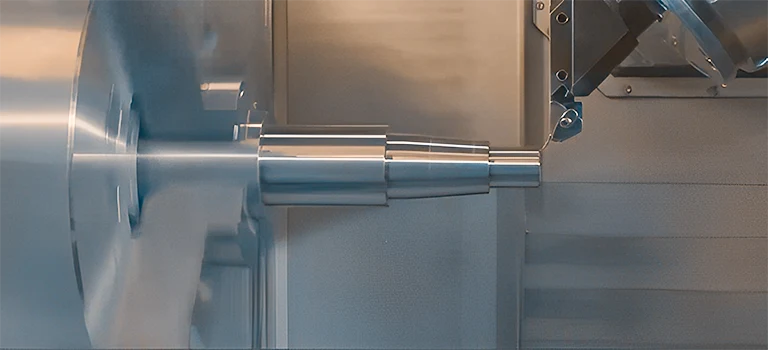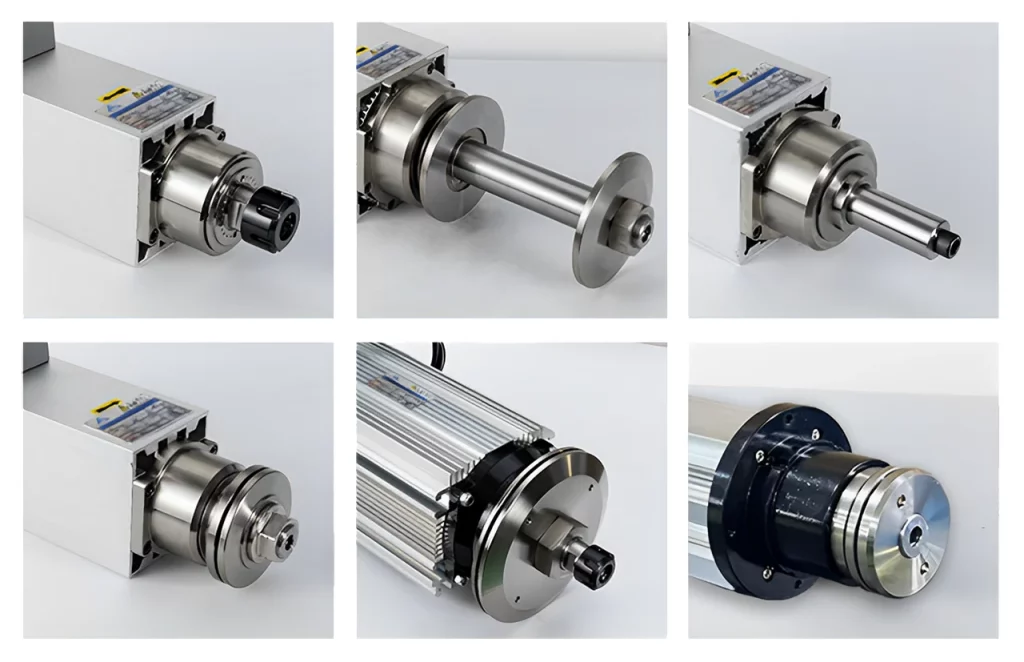Did you know every Máquina CNC has a computer numerical control spindle at its core? The spindle is a crucial machine part, yet most people don’t consider it. A CNC router, engraver, or lathe might have one.
The CNC spindle has a significant impact on machine tool performance. Understanding the spindle mechanism is critical when deciding which spindle to use.
In this article, we will discuss what a CNC spindle is and how it works on machine tools, the types of CNC main spindles, and a short guide to selecting the proper one.

What is the Main Spindle in a CNC Machine?
In a CNC machine, the primary spindle is commonly the shaft at the center of the machine tool’s rotating axis; however, it can also refer to the entire rotary unit, comprising not only the shaft but its bearings and anything attached to it.
Spindles are driven by an axis that receives movement commands from the CNC controller. The spindle of a Mecanizado CNC center is an important component. The form determines the speed and cutting force.
A machine tool may have several spindles, with the largest as the main spindle. Without any further qualifiers, the spindle usually implies the primary spindle.
Spindle configurations and modifications are available to meet the needs of diverse industries. Common examples include lathe spindles, milling machine spindles, grinding spindles, electric spindles, low-speed spindles, high-speed spindles, and so on.
Working of the Main Spindle:
The motor of a CNC spindle is the most crucial component of the device. The application will determine the kind of motor it can use. For instance, lower-end machines might use brushless DC motors, whereas higher-end machines might have air-cooled or liquid-cooled motors.
Both types of cooling are common for motors. The motors utilize a driving system, which can either be an open or a closed loop.
Although open-loop systems are easier to maintain and cost less to operate, closed-loop systems tend to produce more accurate results. On the other hand, closed-loop systems have a higher upfront cost but provide a higher level of precision and control. Closed-loop control is utilized in the majority of current CNC machinery.
Sugerencia: ¿Por qué debería considerar el prototipado CNC? Necesidades de uso, limitaciones y consejos de expertos
For the machine to function correctly, the main spindle needs to be aligned with the axis of the machine. You can access various methods, including optical sensors, LVDTs, and even laser interferometers.

Types of Main Spindle in CNC Machines:
There are many different types of classifications for CNC machining center spindles. Although different nations have different standards, there is a common classification based on the spindle taper. For example, BT60, BT50, BT40, and BT30. The number that comes after BT reflects the taper interface diameter of the tool holder.
The many types of machining centers that are compatible with each of these spindle configurations are distinct. The rotation speed is varied for each spindle because the diameters of the spindles are variable, which directly leads to the machining capabilities being different for each spindle.
Explore Each of These Main Spindle Types:
- The spindle diameter of the BT30 is relatively low, which means that the greatest speed that can be obtained is more than the spindle diameter. It is most commonly used in drilling and tapping centers as well as other types of tiny machining centers, and its primary purpose is to make molds as well as perform drilling and tapping operations.
- The spindle diameter on the BT40 is about average, and there is a cap on the maximum speed. The majority of machining centers utilize the BT40. Both finishing and rough machining can be accomplished with this category of the spindle. It is also applicable for the mold with a big drilling diameter, and among these many types of spindle, its application range is the broadest.
- The BT50 and BT60 are typically used for rough machining. Their maximum speed is just 8000 RPM; the CNC machining center does not typically use this spindle.
Aside from these possibilities, high-speed spindles are the most popular in CNC machine shops. This main spindle is suitable for cutting materials such as aluminum, wood, and composite.
Yet, it is crucial to know that high speed is not required when machining steel, stainless steel, and thermoplastics (Check thermoplastics manufacturing). As a result, it is critical to select a lower RPM spindle for steel processing, but if you want to drill in steel, you should use a more powerful spindle.
Two main spindles exist, including integrated motor spindles and belt-driven spindles.
- Integrated Motor Spindle: It has a maximum speed of 60,000 RPM, which allows it to handle a wide range of milling tasks but restricts its service life.
- Belt-Driven Spindle: With a maximum speed of 15,000 RPM, the belt-driven spindle may generate higher levels of power and torque while being less expensive.

Importance of Main Spindle in a CNC Machine:
When compared to conventional machines, employing a CNC spindle and a CNC machine offers serves great value in the CNC machining process, including the following:
- Firstly, the main spindle provides a higher precision level than manual activities. A computer controls the motor, enabling it to carry out accurate tasks.
- Additionally, CNC spindles give increased speed in addition to improved efficiency. In fact, such type of main spindle can execute even the most difficult tasks quickly, thanks to its capacity to rotate at high speeds.
- One further advantage of CNC spindles is that they can be utilized in various processes. Milling, drilling, tapping, and even turning are all examples of these processes. Due to their adaptability, they are an indispensable component of any CNC machine.
Lea también: Máquina de corte láser CNC 101: Guía de compra detallada
How To Find The Right CNC Spindle?
It is indeed crucial to make an informed decision when selecting a CNC spindle or a milling head. Nevertheless, if you put in a lot of effort, you may finish it in a few hours, and if you work efficiently, it might be sufficient for up to half a year.
Spindles used in professional settings often have brushless inductive inverter control, run on ceramic bearings, and have a tightly sealed engine compartment. Their casings are made entirely of metal. Spindle rotations and power are both options that are available to us.
Understanding the Main Spindle Speed
The speed of the spindle is indicated by the national figure on the identification plate (12,000, 15.000, 18.000, 24.000, or 40.000 revolutions per minute). Yet, this does not always mean that the spindle rotates constantly at these rates.
Even though the inverter may control the number of revolutions, it is crucial to remember that spindle power is calculated by multiplying torque by rotational speed. While keeping the torque constant and reducing spins by half, the power drops by nearly half.
Hence, not every task can be accomplished with a spindle. Mainly because of the restriction on spindle speed, which is caused by the bearings that have increasingly larger diameters as spindle power increases. So the greater the bearing diameter, the greater the centrifugal force exerted on the running tracks located on the bearing’s outer ring.
Considering these speed criteria, aluminum, wood, composite materials, laminates, and similar materials are all excellent candidates for use with a high-speed spindle. In fact, it does not operate at high speed when cutting steel, especially stainless steel, thermoplastics, or drilling with HSS drill bits.
Picking The Main Spindle That Offers Ideal Power:
Concerning the power, it uses the essential criteria, which are the milling cutters with the maximum diameter, and it processes the materials with these cutters.
For steel, we should primarily select a spindle with a lower speed (15,000 to 18,000 rpm) and, correspondingly, cutters up to 10mm requiring 3.3kW, cutters up to 12mm requiring 5.6kW, cutters up to 16mm requiring 7kW, and cutters up to 20mm requiring 10kW.
Main Spindle Material:
If you wish to drill in steel, you must always choose a more powerful spindle because, for example, if you want to drill in steel with a 6mm drill at 2000rpm with the 5.6kW 18,000 rpm spindle, we have just 0.6kW available to us. Therefore, if you intend to drill in steel, you must always select a more powerful spindle.
However, it’s important to note that you cannot compare the capabilities of spindles to the powers of classic milling machines. These machines use gears. Thus, there is no need to have a torque reserve. Considering all this, picking the main spindle accordingly can result in a usage lasting around ten years.
Sugerencia: ¿Cómo elegir la mejor empresa de mecanizado CNC para sus productos?
--
Still have questions about the main spindle in a CNC machine? Ask our expert technicians at Prototool.










